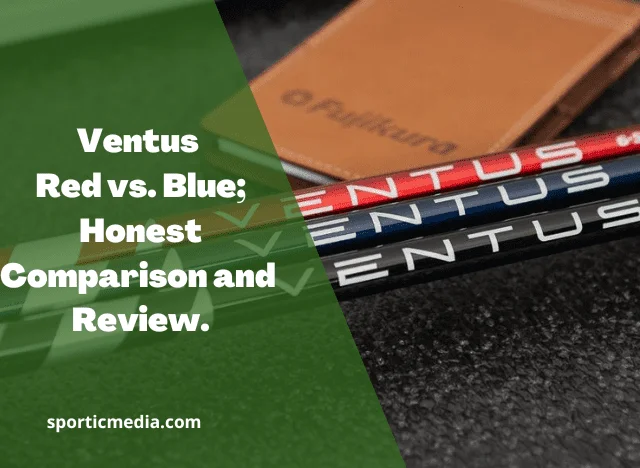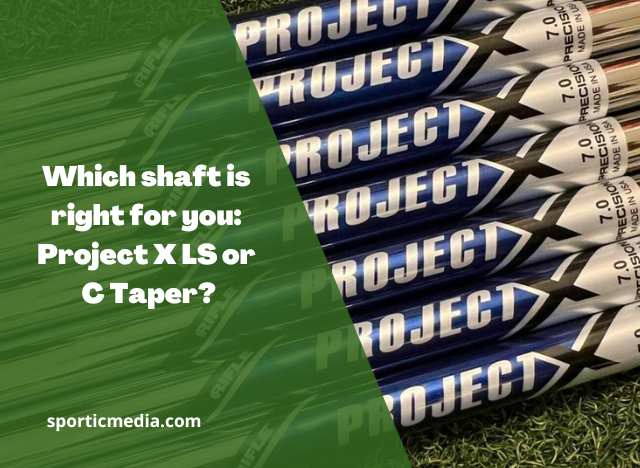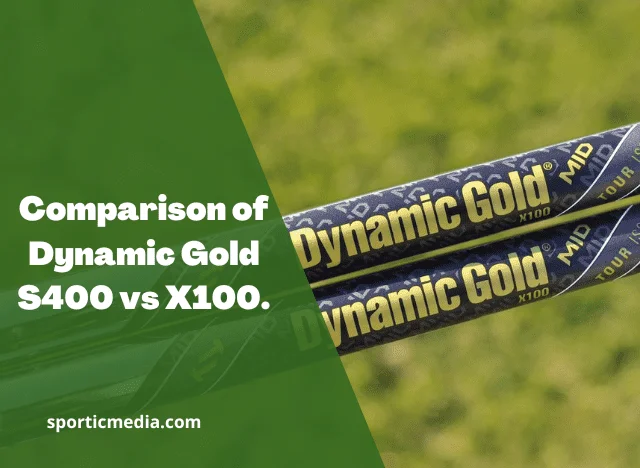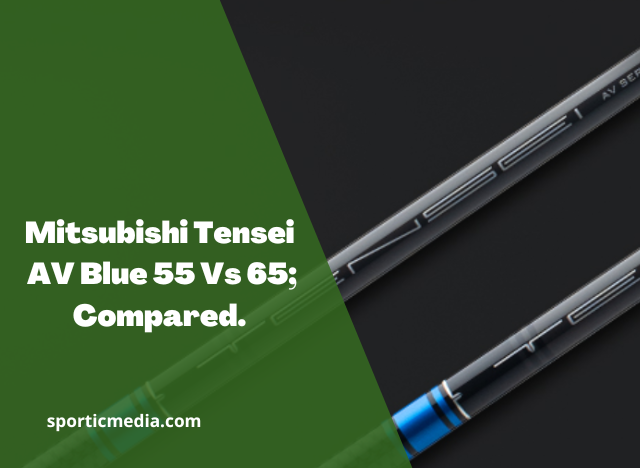The superbly engineered Ventus is intended to greatly reduce shot dispersion and maximize ball speed, particularly on off-centre shots. Fujikura’s Ventus is the first profile with Fujikura’s brand-new VeloCore Technology in an accelerated taper, ultra-stiff tip profile, and the Tour inspires it.
Each shaft is made with an accelerated taper design to increase the load and feel and is built around Fujikura’s VeloCore Technology. The Red profile is made to achieve a slightly higher launch and spin rate than the Blue because it has a more active tip section.
So, in this article, we discuss almost everything you need to know about comparing the Ventus Red and Blue shafts to determine which will best match your career. Stick around until the end to find out what you’ve been looking for, and welcome to Sportic Media.
Table of Contents
What is the significance of the Ventus red shaft?
While Ventus Red and Black’s EI profiles differ slightly from Blue’s, the underlying technology is the same. Each shaft is made with an accelerated taper design to increase the load and feel and is built around Fujikura’s VeloCore Technology.
The Red profile is made to achieve a slightly higher launch and spin rate than the Blue because it has a more active tip section. Justin Thomas and Adam Scott, who have both used the shaft at various points this season, have already found a place for it in their bags.
That higher launch and the spin rate is one of the best reasons why many plates love to select the red ones instead of the blues.
What are the specs of the Ventus red shaft?
Here’s a table including the data for the VENTUS TR Red series of golf shafts:
| Model | Flex | Length | Weight | Tip Flex | Butt Flex | Torque | Par. Tip Length | Butt Diameter | Bend Point | Spin | Launch |
|---|---|---|---|---|---|---|---|---|---|---|---|
| VENTUS TR Red 5 | R2 | 46 | 59 | 120 | 98 | 3.7 | 3.0 | 0.608 | M | M/L | M/H |
| VENTUS TR Red 5 | R | 46 | 59.5 | 110 | 91 | 3.5 | 3.0 | 0.608 | M | M/L | M/H |
| VENTUS TR Red 5 | S | 46 | 59.5 | 102 | 84 | 3.3 | 3.0 | 0.608 | M | M/L | M/H |
| VENTUS TR Red 6 | R | 46 | 67.5 | 104 | 84 | 3.4 | 3.0 | 0.608 | M | M/L | M/H |
| VENTUS TR Red 6 | S | 46 | 68 | 99 | 78 | 3.2 | 3.0 | 0.608 | M | M/L | M/H |
| VENTUS TR Red 6 | X | 46 | 69.5 | 92 | 74 | 3.0 | 3.0 | 0.608 | M | M/L | M/H |
| VENTUS TR Red 7 | S | 46 | 77 | 96 | 74 | 3.0 | 3.0 | 0.608 | M | M/L | M/H |
| VENTUS TR Red 7 | X | 46 | 78 | 91 | 69 | 2.8 | 3.0 | 0.608 | M/H | M/L | M/H |
| VENTUS TR Red 8 | X | 46 | 89.5 | 89 | 64 | 2.7 | 3.0 | 0.608 | M/H | M/L | M/H |
This table includes information about the VENTUS TR Red golf shafts, including their flex, length, weight, tip flex, butt flex, torque, parallel tip length, butt diameter, bend point, spin characteristics, and launch characteristics.
What pros use Ventus Red?
As Ventus Red is very famous in the golf world, many pros, as well as beginners, love to use Ventus Red instead of the Blacks and Blues. So the following are some of the pros who are using Red shafts to play their best golf.
- Hideki Matsuyama,
- Phil Mickelson,
- Rory McIlroy,
- Patrick Cantlay,
- Louis Oosthuizen,
- Jordan Spieth,
- Sergio Garcia,
- Garrick Higgo,
- Adam Scott,
and Nelly Korda are notable golfers who have used a Fujikura Ventus shaft at some point this season.
Is Ventus Red a good shaft?
Because it is a more stable golf shaft during impact, the Ventus Red can be regarded as one of the best on the market, increasing MOI and smash factor.
Additionally, the shot’s feel will be significantly improved. Golfers frequently overlook the necessity of transferring the energy they generate and accumulate during their swing to the golf ball.
Does Ventus Red have VeloCore?
The brand-new Velocore Technology is a feature of the new Fujikura Ventus Red. The Velocore’s distinctive multi-material design will increase the shaft’s stability at impact.
Sportic media
What is the significance of the Ventus blue shaft?
The Ventus Blue is a production of the latest technology, which is why it performs well in almost any condition. The midsection of the shaft, which experiences the majority of the stress during the swing, is reinforced with this incredibly light and durable material. With a torsional stiffness almost 10% higher than Ventus Blue’s, Ventus TR’s mid/handle provides more stability without sacrificing the favored feel of Ventus Blue.
This shaft is exactly halfway between low-mid and mid-launch. Additionally available in versions weighing 56 grams in R, S, and X flex up to 86 grams, but only in S and X flex. According to our testing, ball flight is more mid than low-mid. For many golfers, the VENTUS Blue 5S shaft is superb.
What are the specs of the Ventus blue shaft?
Here’s a table including the data for the VENTUS TR Blue series of golf shafts:
| Model | Flex | Length | Weight | Tip Flex | Butt Flex | Torque | Par. Tip Length | Butt Diameter | Bend Point | Spin | Launch |
|---|---|---|---|---|---|---|---|---|---|---|---|
| VENTUS TR Blue 5 | R2 | 46 | 56 | 112 | 104 | 3.7 | 3.0 | 0.605 | M | L | M |
| VENTUS TR Blue 5 | R | 46 | 58 | 104 | 98 | 3.5 | 3.0 | 0.605 | M | L | M |
| VENTUS TR Blue 5 | S | 46 | 58 | 98 | 90 | 3.3 | 3.0 | 0.605 | M | L | M |
| VENTUS TR Blue 6 | R | 46 | 67.5 | 100 | 90 | 3.3 | 3.0 | 0.605 | M | L | M |
| VENTUS TR Blue 6 | S | 46 | 68 | 94 | 82 | 3.1 | 3.0 | 0.605 | M | L | M |
| VENTUS TR Blue 6 | X | 46 | 68 | 90 | 78 | 2.9 | 3.0 | 0.605 | M | L | M |
| VENTUS TR Blue 6 | TX | 46 | 69.5 | 90 | 71 | 2.9 | 3.0 | 0.610 | M | L | M |
| VENTUS TR Blue 7 | S | 46 | 77.5 | 93 | 80 | 2.9 | 3.0 | 0.605 | M | L | M |
| VENTUS TR Blue 7 | X | 46 | 78.5 | 89 | 74 | 2.7 | 3.0 | 0.605 | M | L | M |
| VENTUS TR Blue 7 | TX | 46 | 80.5 | 89 | 70 | 2.7 | 3.0 | 0.610 | M | L | M |
| VENTUS TR Blue 8 | S | 46 | 86.5 | 91 | 75 | 2.8 | 3.0 | 0.605 | M | L | M |
| VENTUS TR Blue 8 | X | 46 | 88.5 | 88 | 70 | 2.6 | 3.0 | 0.605 | M | L | M |
| VENTUS TR Blue 8 | TX | 46 | 90 | 88 | 62 | 2.6 | 3.0 | 0.610 | M | L | M |
This table includes information about the VENTUS TR Blue golf shafts, including their flex, length, weight, tip flex, butt flex, torque, parallel tip length, butt diameter, bend point, spin characteristics, and launch characteristics.
Incorporating Fujikura’s Pitch Fiber 70 Ton Carbon Fiber, the Ventus Blue shaft takes durability to the next level. This advanced material, boasting 150% more strength and stability than T1100g, ensures that your investment in this shaft is a long-lasting one.
The Ventus Blue lineup offers a range of flex options to cater to golfers with various swing speeds. Additionally, it comes in different lengths, allowing golfers to fine-tune their club’s fit according to their unique swing dynamics.
Key Specifications of the Ventus Blue Shaft:
- Shaft Profile: Mid-launch, low-spin
- Construction: Proprietary multi-material bias core
- Material: Pitch Fiber 70 Ton Carbon Fiber
- Available Flexes: R2, R, S, X
- Length Options: 46 inches, 46.5 inches, 47 inches
For golfers in search of a shaft that enhances consistency and accuracy in their game, the Ventus Blue is a highly recommended choice. Its technology-driven design ensures that you can achieve more predictable and precise ball flights, ultimately helping you lower your scores on the golf course.
Fujikura Ventus Blue 5 vs. 6: Unveiling the Differences
sportic media
Finally, what is the difference between Ventus blue and red shafts?
Choosing the right golf shaft can greatly impact your performance on the course. The Ventus Blue and Ventus Red shafts from Fujikura are both high-quality options, but they have some differences that can make a big difference in your game. Let’s break it down in simple terms:
Ventus Blue:
What’s It Like? – The Ventus Blue has a more “active” tip section. That means it bends more towards the end of the shaft. This gives your shots a bit higher launch and more spin. It also has a lively, “responsive” feel when you hit the ball. Some golfers really like that.
Who Should Use It? – If you often struggle with making the ball go straight and avoiding hooks or slices, the Ventus Blue could be your friend. It’s designed to help you hit straighter shots with less spin.
Ventus Red:
What’s It Like? – The Ventus Red is a bit different. It has a more “stable” tip section, meaning it doesn’t bend as much at the end. This leads to a slightly lower launch and less spin. It also has a more “dampened” feel, which is a bit softer and muted when you hit the ball.
Who Should Use It? – If you have trouble getting good distance on your drives or you’re not consistent with your shots, the Ventus Red could be a good choice. It’s meant to give you a longer ball flight with more forgiveness.
Which One Is Right for You?
- Ventus Blue might be your pick if you want straighter shots with a bit more spin, like a responsive feel, and struggle with hooks or slices.
- Ventus Red could be your choice if you need more distance, prefer a softer feel, and want to reduce spin for a more forgiving flight.
Here are some extra things to think about:
Swing Speed: If you swing the club really fast (95 mph or more), Ventus Blue is often recommended. For slightly slower swings (85-95 mph), Ventus Red is a good match.
Ball Flight: If you naturally hit the ball high and far, Ventus Blue can help. If your shots tend to be lower and shorter, Ventus Red could be the answer.
Feel: Some golfers like a lively, “responsive” feel, while others prefer a softer, “dampened” feel. If you’re not sure which one you like, it’s smart to get fitted by a professional who can help you decide.
In the end, the best way to figure out which shaft is perfect for you is to get fitted by a professional. They can study your swing and suggest the shaft that fits you the best. So, whether you’re looking for straighter shots with less spin (Ventus Blue) or longer drives with more forgiveness (Ventus Red), the right choice can help you improve your golf game.
Fujikura Ventus Swing Speed Chart: All You Need To Know
sportic media
Fujikura Ventus swing speed chart

The full range of Cool Clubs’ building and fitting capabilities, including elements like tipping and build length that can make a shaft play either softer or stiffer, is taken into consideration when making these recommendations.
You might want to make these ranges smaller to make things a little clearer. From a fitting standpoint, the sweet spot starts at 25% from the slow end of the range.
Players with faster swing tempos, especially in transition, may typically fit into a stiff flex, whereas smoother swingers frequently fit into a softer flex.
What is the difference between Ventus blue and black?
As we’ve mentioned, the Ventus Blue and Black golf shafts from Fujikura are both high-quality options for your driver, but they have some differences to consider.
Let’s break it down in simple terms:
Ventus Blue:
- What’s It Like? – The Ventus Blue has a tip section that’s a bit more “active,” which means it bends more towards the end. This gives your shots a bit higher launch and a little more spin. It also has a lively, “responsive” feel when you hit the ball.
- Who Should Use It? – If you struggle with hitting the ball straight and want to reduce hooks or slices, the Ventus Blue can help. It’s designed to make your shots go straighter with less spin.
Ventus Black:
- What’s It Like? – The Ventus Black is a bit different. It has a more “stable” tip section, which means it doesn’t bend as much at the end. This leads to a slightly lower launch and less spin. It also has a softer, “dampened” feel when you make contact with the ball.
- Who Should Use It? – If you need more distance or want forgiveness for inconsistent shots, the Ventus Black is a good choice. It’s meant to give you a longer ball flight with more forgiveness.
Which One Is Right for You?
- Ventus Blue could be your pick if you want straighter shots with a bit more spin, enjoy a responsive feel, and struggle with hooks or slices.
- Ventus Black might be your choice if you need more distance, prefer a softer feel, and want a more stable shaft.
Here are some extra things to think about:
- Stability: Ventus Blue is slightly less stable, while Ventus Black is a bit more stable. So, if you’re comfortable with a slightly less stable shaft, you can go with the Ventus Black.
In the end, the best way to find your perfect shaft is to get fitted by a professional. They can watch your swing and suggest the shaft that suits you best. So, whether you’re looking for straighter shots with less spin (Ventus Blue) or longer drives with more forgiveness (Ventus Black), the right choice can help you improve your golf game.
How stiff is Ventus black?
A golf shaft with an extremely stiff tip and butt section and a more active middle section is called Ventus Black.
- 60 gram stiff and extra stiff,
- 70 gram stiff and extra stiff,
and 80 gram extra stiff are the three different models of Ventus Black.
Fujikura Ventus Red 5 Golf Shaft Review: A Game-Changer for Golfers of All Levels
sportic media
Some related FAQs.
Why is the Ventus shaft so popular?
The midsection of the shaft, which experiences the majority of the stress during the swing, is reinforced with this incredibly light and durable material.
With a torsional stiffness almost 10% higher than Ventus Blue’s, Ventus TR’s mid/handle provides more stability without sacrificing the favored feel of Ventus Blue.
What are Ventus shafts made of?
The premium/exotic carbon composite material known as Pitch 70 contributes to Ventus’ low-ish spin characteristics.
We don’t expect you to be a carbon fiber expert, but you should be aware that Pitch 70 is 150% stiffer than T1100g, which is the material used in many low spin shaft designs.
Where are Fujikura Ventus shafts made?
Two teams of engineers prototype their shafts in Japan and the US.
What type of shaft does Tiger Woods use?
Tuesday, the Woods’ TaylorMade Stealth Plus driver was fitted with a Fujikura Ventus Black 6 X shaft.
When switching from True Temper’s new Dynamic Gold MID Tour Issue X100 shafts, Woods also has a new shaft in his P770 3-iron.
Discover the meticulous and expert-driven process behind our product reviews at Sportic Media. Our comprehensive guide, led by industry veterans, ensures you get the most reliable and detailed insights into golf equipment. Dive into our methodical approach by visiting How We Test Products at Sportic Media: A Comprehensive Guide
.







